check engine MAZDA MODEL 6 2007 (in English) User Guide
[x] Cancel search | Manufacturer: MAZDA, Model Year: 2007, Model line: MODEL 6, Model: MAZDA MODEL 6 2007Pages: 384, PDF Size: 4.22 MB
Page 165 of 384
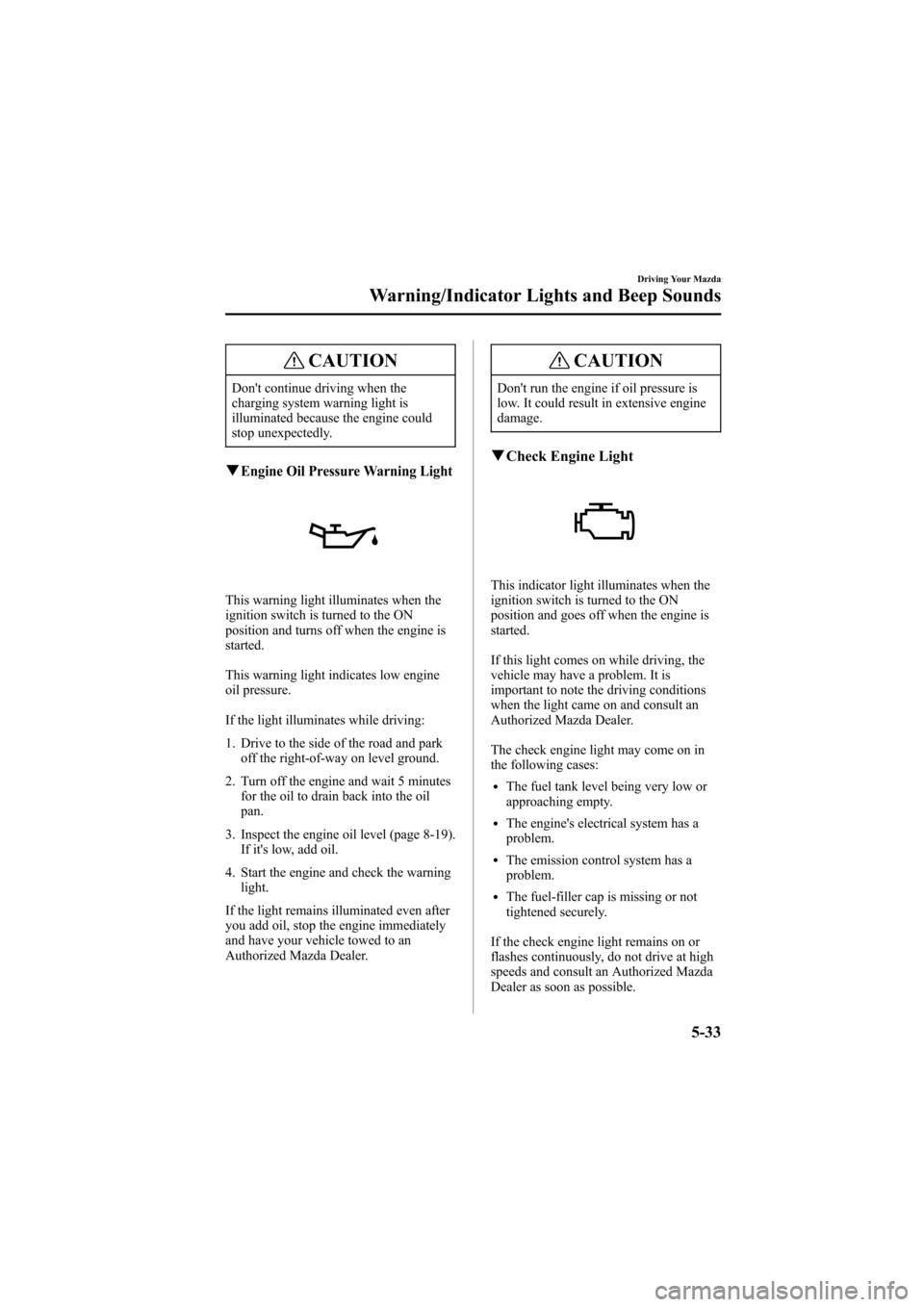
Black plate (165,1)
CAUTION
Don't continue driving when the
charging system warning light is
illuminated because the engine could
stop unexpectedly.
qEngine Oil Pressure Warning Light
This warning light illuminates when the
ignition switch is turned to the ON
position and turns off when the engine is
started.
This warning light indicates low engine
oil pressure.
If the light illuminates while driving:
1. Drive to the side of the road and park
off the right-of-way on level ground.
2. Turn off the engine and wait 5 minutes
for the oil to drain back into the oil
pan.
3. Inspect the engine oil level (page 8-19).
If it's low, add oil.
4. Start the engine and check the warning
light.
If the light remains illuminated even after
you add oil, stop the engine immediately
and have your vehicle towed to an
Authorized Mazda Dealer.
CAUTION
Don't run the engine if oil pressure is
low. It could result in extensive engine
damage.
qCheck Engine Light
This indicator light illuminates when the
ignition switch is turned to the ON
position and goes off when the engine is
started.
If this light comes on while driving, the
vehicle may have a problem. It is
important to note the driving conditions
when the light came on and consult an
Authorized Mazda Dealer.
The check engine light may come on in
the following cases:
lThe fuel tank level being very low or
approaching empty.
lThe engine's electrical system has a
problem.
lThe emission control system has a
problem.
lThe fuel-filler cap is missing or not
tightened securely.
If the check engine light remains on or
flashes continuously, do not drive at high
speeds and consult an Authorized Mazda
Dealer as soon as possible.
Driving Your Mazda
Warning/Indicator Lights and Beep Sounds
5-33
Mazda6_8W89-EA-06K_Edition1 Page165
Tuesday, November 14 2006 1:23 PM
Form No.8W89-EA-06K
Page 184 of 384
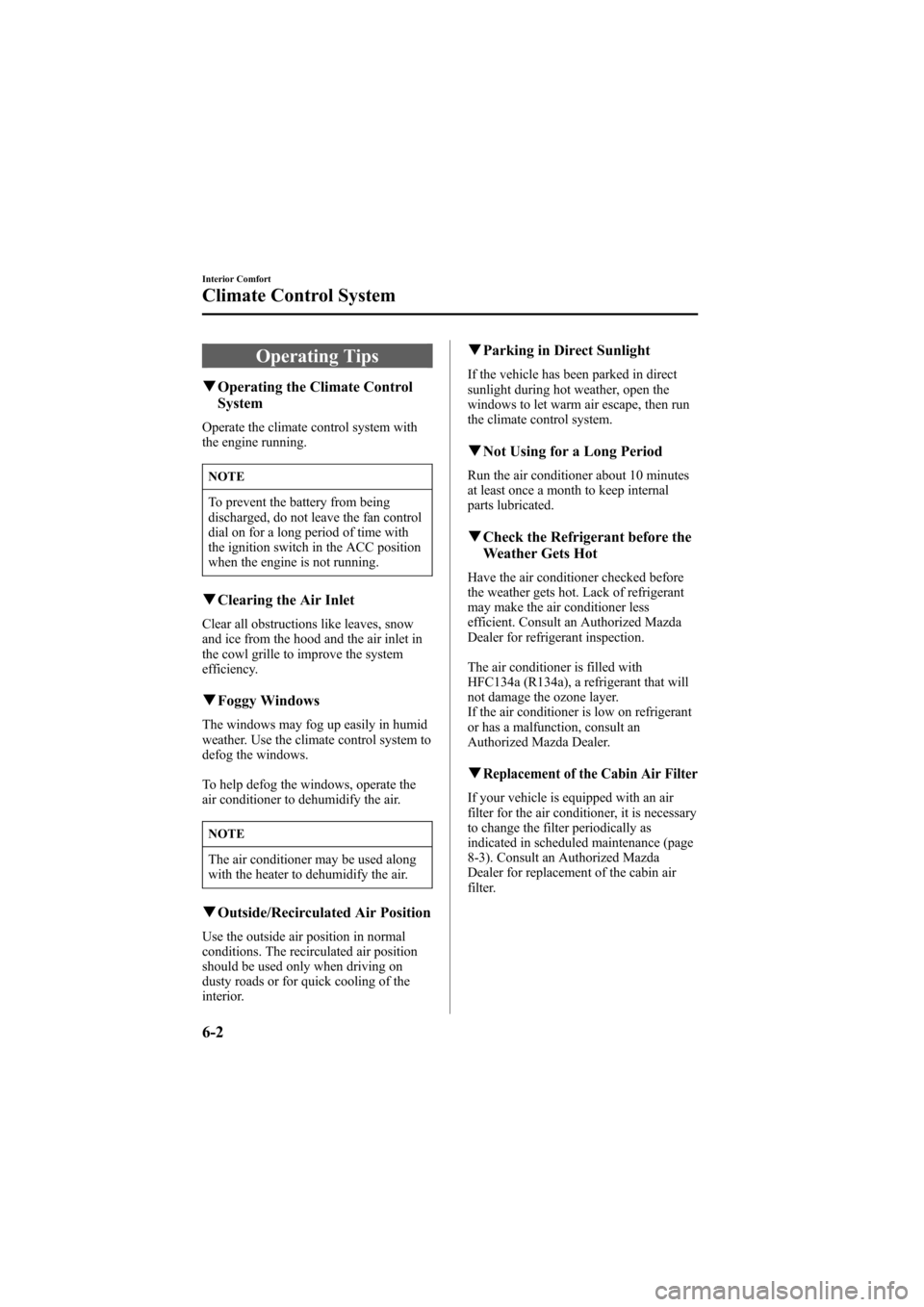
Black plate (184,1)
Operating Tips
qOperating the Climate Control
System
Operate the climate control system with
the engine running.
NOTE
To prevent the battery from being
discharged, do not leave the fan control
dial on for a long period of time with
the ignition switch in the ACC position
when the engine is not running.
qClearing the Air Inlet
Clear all obstructions like leaves, snow
and ice from the hood and the air inlet in
the cowl grille to improve the system
efficiency.
qFoggy Windows
The windows may fog up easily in humid
weather. Use the climate control system to
defog the windows.
To help defog the windows, operate the
air conditioner to dehumidify the air.
NOTE
The air conditioner may be used along
with the heater to dehumidify the air.
qOutside/Recirculated Air Position
Use the outside air position in normal
conditions. The recirculated air position
should be used only when driving on
dusty roads or for quick cooling of the
interior.
qParking in Direct Sunlight
If the vehicle has been parked in direct
sunlight during hot weather, open the
windows to let warm air escape, then run
the climate control system.
qNot Using for a Long Period
Run the air conditioner about 10 minutes
at least once a month to keep internal
parts lubricated.
qCheck the Refrigerant before the
Weather Gets Hot
Have the air conditioner checked before
the weather gets hot. Lack of refrigerant
may make the air conditioner less
efficient. Consult an Authorized Mazda
Dealer for refrigerant inspection.
The air conditioner is filled with
HFC134a (R134a), a refrigerant that will
not damage the ozone layer.
If the air conditioner is low on refrigerant
or has a malfunction, consult an
Authorized Mazda Dealer.
qReplacement of the Cabin Air Filter
If your vehicle is equipped with an air
filter for the air conditioner, it is necessary
to change the filter periodically as
indicated in scheduled maintenance (page
8-3). Consult an Authorized Mazda
Dealer for replacement of the cabin air
filter.
6-2
Interior Comfort
Climate Control System
Mazda6_8W89-EA-06K_Edition1 Page184
Tuesday, November 14 2006 1:24 PM
Form No.8W89-EA-06K
Page 257 of 384
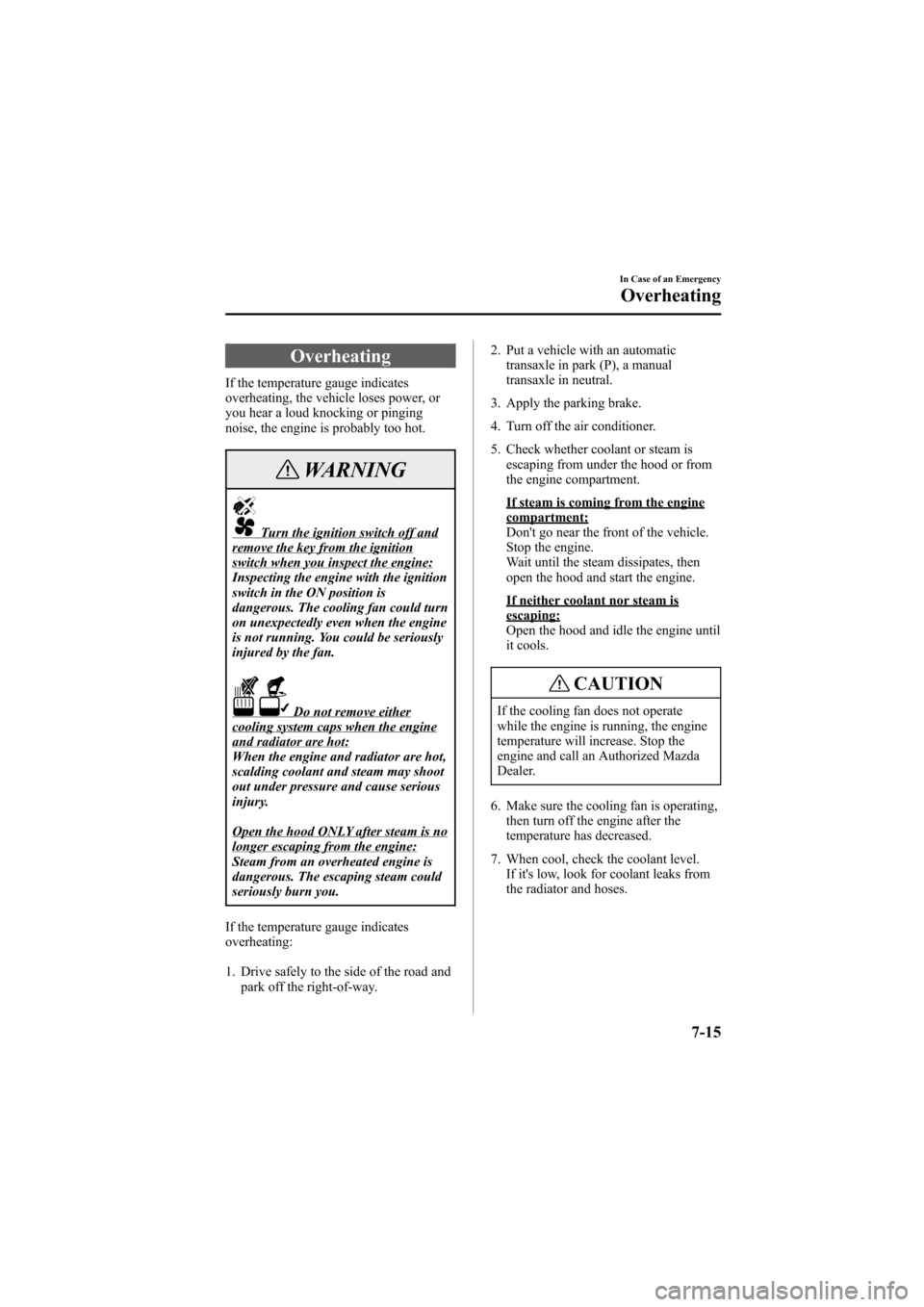
Black plate (257,1)
Overheating
If the temperature gauge indicates
overheating, the vehicle loses power, or
you hear a loud knocking or pinging
noise, the engine is probably too hot.
WARNING
Turn the ignition switch off andremove the key from the ignitionswitch when you inspect the engine:
Inspecting the engine with the ignition
switch in the ON position is
dangerous. The cooling fan could turn
on unexpectedly even when the engine
is not running. You could be seriously
injured by the fan.
Do not remove eithercooling system caps when the engineand radiator are hot:
When the engine and radiator are hot,
scalding coolant and steam may shoot
out under pressure and cause serious
injury.
Open the hood ONLY after steam is nolonger escaping from the engine:
Steam from an overheated engine is
dangerous. The escaping steam could
seriously burn you.
If the temperature gauge indicates
overheating:
1. Drive safely to the side of the road and
park off the right-of-way.2. Put a vehicle with an automatic
transaxle in park (P), a manual
transaxle in neutral.
3. Apply the parking brake.
4. Turn off the air conditioner.
5. Check whether coolant or steam is
escaping from under the hood or from
the engine compartment.
If steam is coming from the enginecompartment:
Don't go near the front of the vehicle.
Stop the engine.
Wait until the steam dissipates, then
open the hood and start the engine.
If neither coolant nor steam isescaping:
Open the hood and idle the engine until
it cools.
CAUTION
If the cooling fan does not operate
while the engine is running, the engine
temperature will increase. Stop the
engine and call an Authorized Mazda
Dealer.
6. Make sure the cooling fan is operating,
then turn off the engine after the
temperature has decreased.
7. When cool, check the coolant level.
If it's low, look for coolant leaks from
the radiator and hoses.
In Case of an Emergency
Overheating
7-15
Mazda6_8W89-EA-06K_Edition1 Page257
Tuesday, November 14 2006 1:24 PM
Form No.8W89-EA-06K
Page 288 of 384

Black plate (288,1)
If new fluid is required frequently, consult
an Authorized Mazda Dealer.
3.0-liter engine
Inspect the fluid level at each engine oil
change. Add fluid if necessary; it does not
require periodic changing.
LowOK HighLoosenTighten
The level must be kept between the H and
L marks.
Visually examine the lines and hoses for
leaks and damage.
1. Park on a level surface, well off the
right-of-way, and set the parking brake
firmly.
2. Turn off the engine and allow it to
cool.
3. Remove the filler cap and attached
dipstick.
4. Wipe them clean and put them back.
5. Remove again and inspect the level.
6. It must be between H and L. Add fluid
if necessary.
Don't overfill.
If new fluid is required frequently, consult
an Authorized Mazda Dealer.
Automatic Transaxle Fluid
(ATF)
qInspecting Automatic Transaxle
Fluid Level
The automatic transaxle fluid level should
be inspected regularly. Measure it as
described below.
2.3-liter engine
CAUTION
lAlways check the automatic
transaxle fluid level according to the
following procedure. If the
procedure is not done correctly, the
automatic transaxle fluid level
cannot be measured accurately
which could lead to automatic
transaxle damage.
lA low fluid level can cause transaxle
slippage. Overfilling can cause
foaming, loss of fluid, and transaxle
malfunction.
lUse only the specified fluid. A non-
specified fluid could result in
transaxle malfunction and failure.
1. Park on a level surface and set the
parking brake firmly.
2. Make sure there is no ATF leakage
from the ATF hose or the housing.
3. Shift the shift lever to the park position
(P), start the engine and warm it up.
8-24
Maintenance and Care
Owner Maintenance
Mazda6_8W89-EA-06K_Edition1 Page288
Tuesday, November 14 2006 1:25 PM
Form No.8W89-EA-06K
Page 289 of 384

Black plate (289,1)
CAUTION
Do not shift the shift lever while the
engine is warming up. If the ATF level
is extremely low, the automatic
transaxle could be damaged.
4. While the engine is still idling, pull out
the dipstick and wipe it clean, and then
put it back.
5. Check the ATF level. If there is no ATF
adhering 5 mm from the end of the
dipstick, add ATF.
CAUTION
If there is no ATF adhering to the
dipstick even after the engine has been
warmed up, do not drive the vehicle.
Otherwise, the automatic transaxle
could be damaged.
6. Shift the shift lever to each range and
position, and make sure there is no
abnormality.
7. Drive the vehicle on city roads for
5 km (3.1 mile) or more.
8. Park on a level surface and set the
parking brake firmly.9. Shift the shift lever to the park position
(P), check the ATF level while the
engine is idling, and make sure that the
ATF level is within the proper level. If
the ATF level is not within the proper
level, add ATF.
The proper fluid level is marked on the
dipstick as follows.
Low Full 2.3-liter engine
3.0-liter engine
The volume of fluid changes with the
temperature. Fluid must be checked at idle
without driving at normal operating
temperature.
CAUTION
lLow fluid level causes transaxle
slippage. Overfilling can cause
foaming, loss of fluid, and transaxle
malfunction.
lUse specified fluid (page 10-5). A
nonspecified fluid could result in
transaxle malfunction and failure.
1. Park on a level surface and set the
parking brake firmly.
2. Start the engine and depress the brake
pedal.
Maintenance and Care
Owner Maintenance
8-25
Mazda6_8W89-EA-06K_Edition1 Page289
Tuesday, November 14 2006 1:25 PM
Form No.8W89-EA-06K
Page 373 of 384
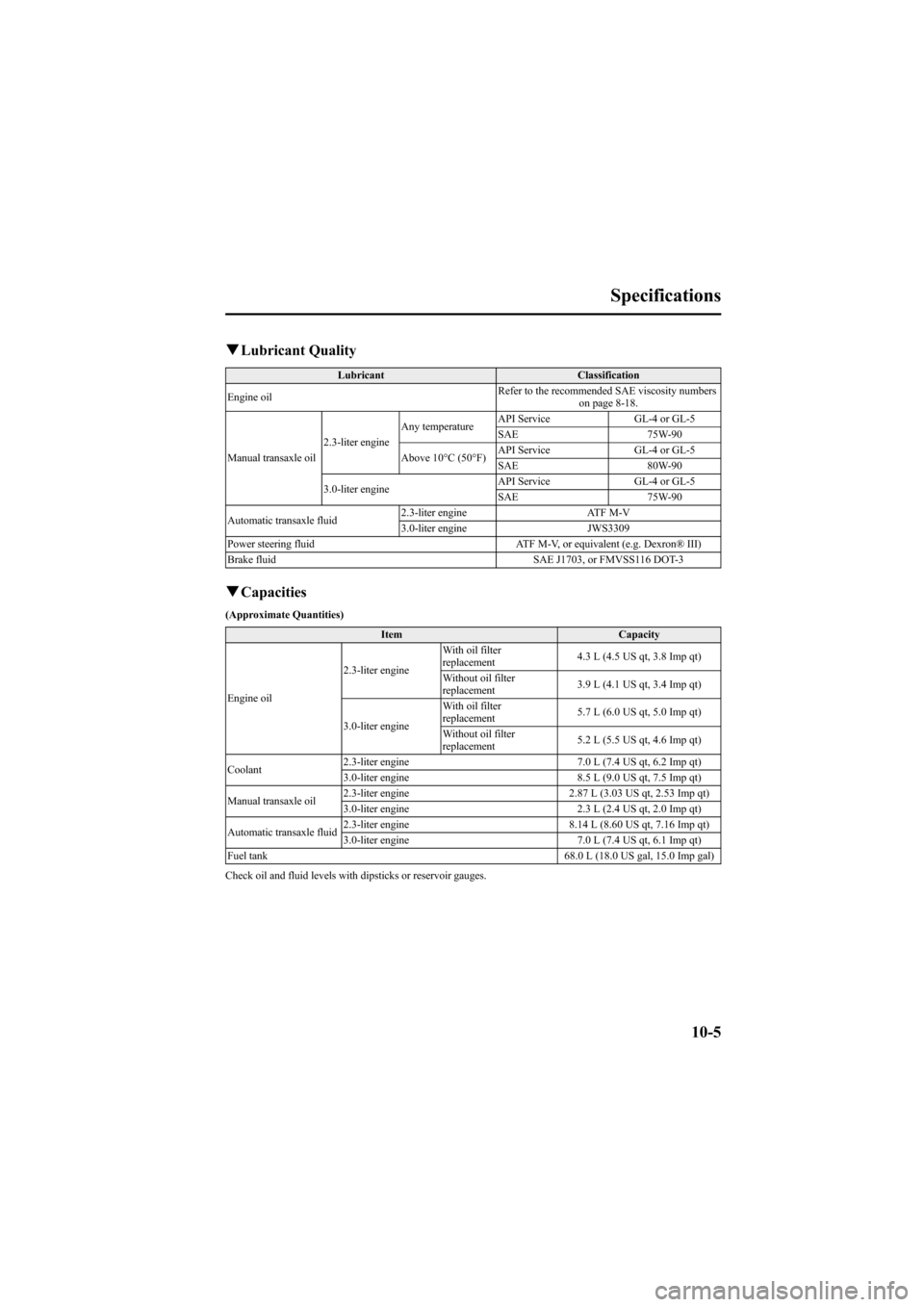
Black plate (373,1)
qLubricant Quality
Lubricant Classification
Engine oilRefer to the recommended SAE viscosity numbers
on page 8-18.
Manual transaxle oil2.3-liter engineAny temperatureAPI Service GL-4 or GL-5
SAE 75W-90
Above 10°C (50°F)API Service GL-4 or GL-5
SAE 80W-90
3.0-liter engineAPI Service GL-4 or GL-5
SAE 75W-90
Automatic transaxle fluid2.3-liter engine ATF M-V
3.0-liter engine JWS3309
Power steering fluid ATF M-V, or equivalent (e.g. Dexron® III)
Brake fluid SAE J1703, or FMVSS116 DOT-3
qCapacities
(Approximate Quantities)
Item Capacity
Engine oil2.3-liter engineWith oil filter
replacement4.3 L (4.5 US qt, 3.8 Imp qt)
Without oil filter
replacement3.9 L (4.1 US qt, 3.4 Imp qt)
3.0-liter engineWith oil filter
replacement5.7 L (6.0 US qt, 5.0 Imp qt)
Without oil filter
replacement5.2 L (5.5 US qt, 4.6 Imp qt)
Coolant2.3-liter engine 7.0 L (7.4 US qt, 6.2 Imp qt)
3.0-liter engine 8.5 L (9.0 US qt, 7.5 Imp qt)
Manual transaxle oil2.3-liter engine 2.87 L (3.03 US qt, 2.53 Imp qt)
3.0-liter engine 2.3 L (2.4 US qt, 2.0 Imp qt)
Automatic transaxle fluid2.3-liter engine 8.14 L (8.60 US qt, 7.16 Imp qt)
3.0-liter engine 7.0 L (7.4 US qt, 6.1 Imp qt)
Fuel tank 68.0 L (18.0 US gal, 15.0 Imp gal)
Check oil and fluid levels with dipsticks or reservoir gauges.
Specifications
10-5
Mazda6_8W89-EA-06K_Edition1 Page373
Tuesday, November 14 2006 1:25 PM
Form No.8W89-EA-06K
Page 382 of 384
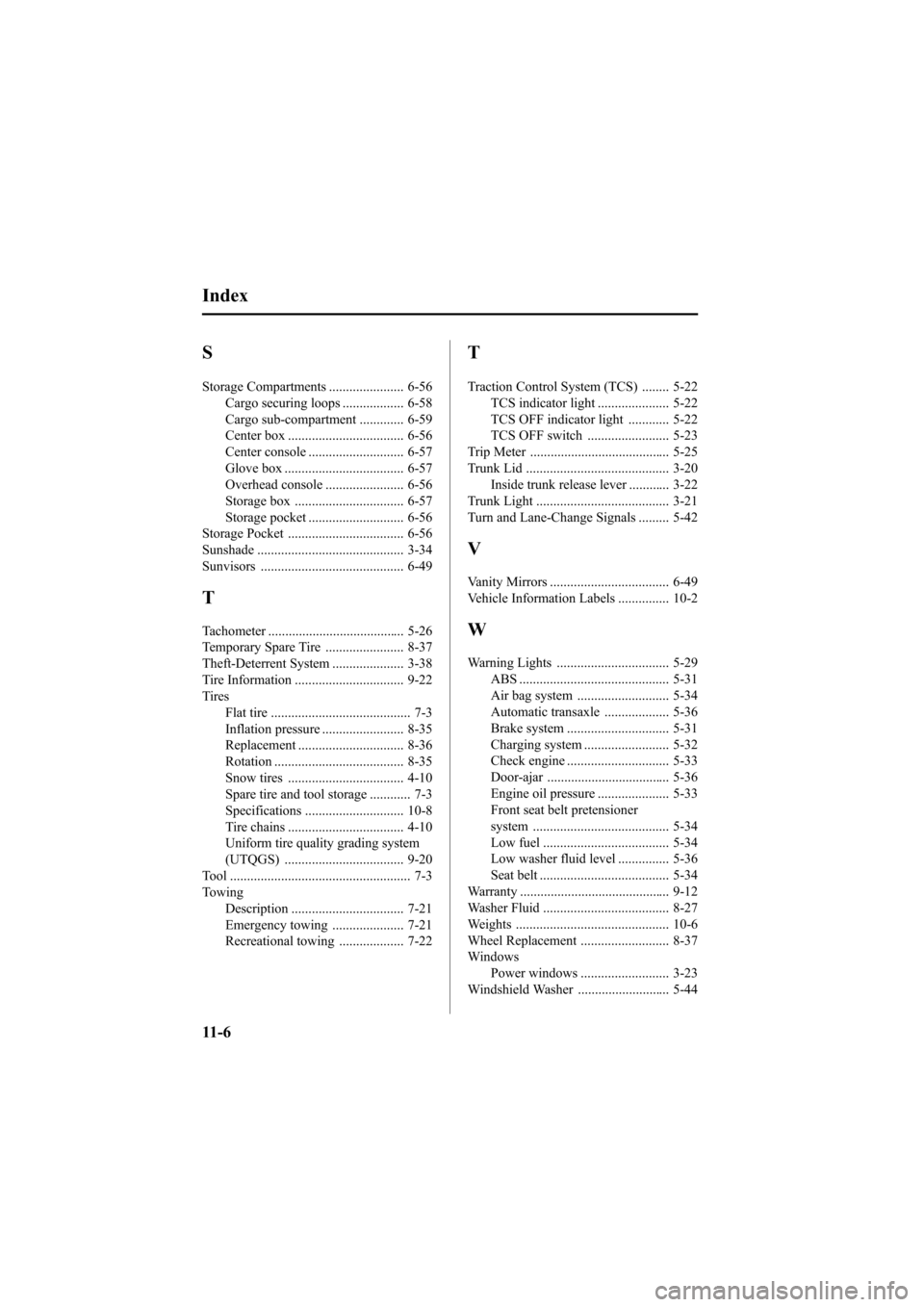
Black plate (382,1)
S
Storage Compartments ...................... 6-56
Cargo securing loops .................. 6-58
Cargo sub-compartment ............. 6-59
Center box .................................. 6-56
Center console ............................ 6-57
Glove box ................................... 6-57
Overhead console ....................... 6-56
Storage box ................................ 6-57
Storage pocket ............................ 6-56
Storage Pocket .................................. 6-56
Sunshade ........................................... 3-34
Sunvisors .......................................... 6-49
T
Tachometer ........................................ 5-26
Temporary Spare Tire ....................... 8-37
Theft-Deterrent System ..................... 3-38
Tire Information ................................ 9-22
Tires
Flat tire ......................................... 7-3
Inflation pressure ........................ 8-35
Replacement ............................... 8-36
Rotation ...................................... 8-35
Snow tires .................................. 4-10
Spare tire and tool storage ............ 7-3
Specifications ............................. 10-8
Tire chains .................................. 4-10
Uniform tire quality grading system
(UTQGS) ................................... 9-20
Tool ..................................................... 7-3
Towing
Description ................................. 7-21
Emergency towing ..................... 7-21
Recreational towing ................... 7-22
T
Traction Control System (TCS) ........ 5-22
TCS indicator light ..................... 5-22
TCS OFF indicator light ............ 5-22
TCS OFF switch ........................ 5-23
Trip Meter ......................................... 5-25
Trunk Lid .......................................... 3-20
Inside trunk release lever ............ 3-22
Trunk Light ....................................... 3-21
Turn and Lane-Change Signals ......... 5-42
V
Vanity Mirrors ................................... 6-49
Vehicle Information Labels ............... 10-2
W
Warning Lights ................................. 5-29
ABS ............................................ 5-31
Air bag system ........................... 5-34
Automatic transaxle ................... 5-36
Brake system .............................. 5-31
Charging system ......................... 5-32
Check engine .............................. 5-33
Door-ajar .................................... 5-36
Engine oil pressure ..................... 5-33
Front seat belt pretensioner
system ........................................ 5-34
Low fuel ..................................... 5-34
Low washer fluid level ............... 5-36
Seat belt ...................................... 5-34
Warranty ............................................ 9-12
Washer Fluid ..................................... 8-27
Weights ............................................. 10-6
Wheel Replacement .......................... 8-37
Windows
Power windows .......................... 3-23
Windshield Washer ........................... 5-44
11-6
Index
Mazda6_8W89-EA-06K_Edition1 Page382
Tuesday, November 14 2006 1:25 PM
Form No.8W89-EA-06K